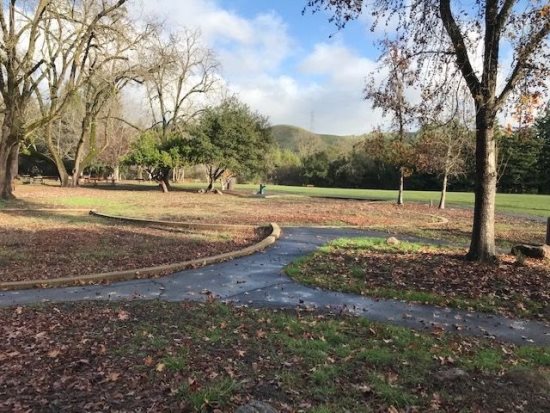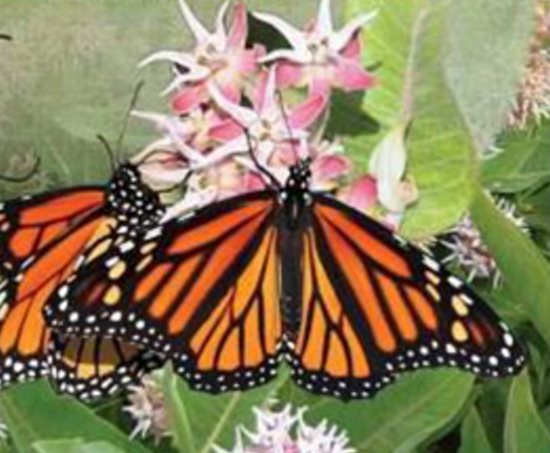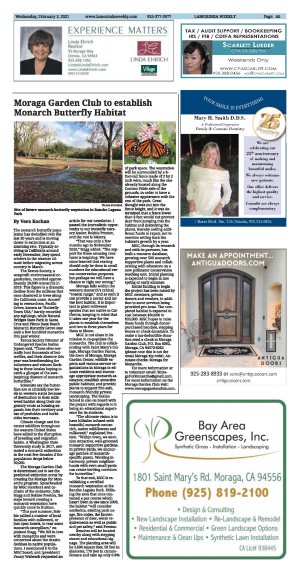| | Published February 3rd, 2021
| Moraga Garden Club to establish Monarch Butterfly Habitat
| | | By Vera Kochan |  | | Site of future monarch butterfly waystation in Rancho Laguna Park Photos Provided |
The monarch butterfly population has dwindled over the last 30 years and is moving closer to extinction at an alarming rate. Typically arriving in California around early November, they spend winters in the warmer climate before migrating across country in March.
 The Xerces Society, a nonprofit environmental organization, recorded approximately 29,000 monarchs in 2019. This figure is a dramatic decline from the millions that once clustered in trees along the California coast. According to researchers, Pacific Grove, known as "Butterfly Town USA," barely recorded any sightings, while Natural Bridges State Park in Santa Cruz and Pismo State Beach Monarch Butterfly Grove saw only a few hundred monarchs this past winter.
The Xerces Society, a nonprofit environmental organization, recorded approximately 29,000 monarchs in 2019. This figure is a dramatic decline from the millions that once clustered in trees along the California coast. According to researchers, Pacific Grove, known as "Butterfly Town USA," barely recorded any sightings, while Natural Bridges State Park in Santa Cruz and Pismo State Beach Monarch Butterfly Grove saw only a few hundred monarchs this past winter.
 Xerces Society Director of Endangered Species Sarina Jepsen said, "These sites normally host thousands of butterflies, and their absence this year was heartbreaking for volunteers and visitors flocking to these locales hoping to catch a glimpse of the awe-inspiring clusters of monarch butterflies."
Xerces Society Director of Endangered Species Sarina Jepsen said, "These sites normally host thousands of butterflies, and their absence this year was heartbreaking for volunteers and visitors flocking to these locales hoping to catch a glimpse of the awe-inspiring clusters of monarch butterflies."
 Scientists say the butterflies are at critically low levels in western states because of destruction to their milkweed habitat along their migratory route as housing expands into their territory and use of pesticides and herbicides increases.
Scientists say the butterflies are at critically low levels in western states because of destruction to their milkweed habitat along their migratory route as housing expands into their territory and use of pesticides and herbicides increases.
 Climate change and the recent wildfires throughout the western United States have added to the disruption of breeding and migration habits. A Washington State University study in 2017, estimated a monarch extinction in the next few decades if the population drops below 30,000.
Climate change and the recent wildfires throughout the western United States have added to the disruption of breeding and migration habits. A Washington State University study in 2017, estimated a monarch extinction in the next few decades if the population drops below 30,000.
 The Moraga Garden Club is determined not to see the predicted extinction occur by creating the Moraga for Monarchs program. Spearheaded by MGC members and co-chairs of the endeavor, Julie Stagg and Bobbie Preston, the steps toward creating a monarch waystation have quickly come to fruition.
The Moraga Garden Club is determined not to see the predicted extinction occur by creating the Moraga for Monarchs program. Spearheaded by MGC members and co-chairs of the endeavor, Julie Stagg and Bobbie Preston, the steps toward creating a monarch waystation have quickly come to fruition.
 "This past summer, Bobbie rallied a number of local families with milkweed, or just open hearts, to rear some monarch caterpillars," explained Stagg. "We fell in love with monarchs and were concerned about the drastic declines in native populations. I mentioned it to the MGC board, and [president] Penny Walwark requested an article for our newsletter. I passed the journalistic opportunity to our butterfly nursery leader, Bobbie Preston, and the rest is history.
"This past summer, Bobbie rallied a number of local families with milkweed, or just open hearts, to rear some monarch caterpillars," explained Stagg. "We fell in love with monarchs and were concerned about the drastic declines in native populations. I mentioned it to the MGC board, and [president] Penny Walwark requested an article for our newsletter. I passed the journalistic opportunity to our butterfly nursery leader, Bobbie Preston, and the rest is history.
 "That was only a few months ago in November 2020," Stagg added. "The support for these amazing creatures is inspiring. We have since learned that rearing should only be done in small numbers for educational versus conservation purposes, but perhaps we will have a chance to right our wrong."
"That was only a few months ago in November 2020," Stagg added. "The support for these amazing creatures is inspiring. We have since learned that rearing should only be done in small numbers for educational versus conservation purposes, but perhaps we will have a chance to right our wrong."
 Moraga falls within the western monarch's critical "coastal range," and as such it can provide a nectar and larvae host habitat. It is important to plant milkweed species that are native to California, keeping in mind that it takes one year for the plants to establish themselves and two to three years for them to bloom.
Moraga falls within the western monarch's critical "coastal range," and as such it can provide a nectar and larvae host habitat. It is important to plant milkweed species that are native to California, keeping in mind that it takes one year for the plants to establish themselves and two to three years for them to bloom.
 MGC is not alone in its mission to re-populate the monarchs. The club is collaborating with Saint Mary's College, Moraga Garden Farms, the town of Moraga, Moraga Garden Center, wildlife experts and various service organizations in Moraga to educate residents and encourage appropriate monarch assistance; establish attractive public habitats; and provide plants to support fire-safe, monarch-friendly private landscaping. The Saklan School is also on board with the project with regards to it being an educational experience for its students.
MGC is not alone in its mission to re-populate the monarchs. The club is collaborating with Saint Mary's College, Moraga Garden Farms, the town of Moraga, Moraga Garden Center, wildlife experts and various service organizations in Moraga to educate residents and encourage appropriate monarch assistance; establish attractive public habitats; and provide plants to support fire-safe, monarch-friendly private landscaping. The Saklan School is also on board with the project with regards to it being an educational experience for its students.
 "The ultimate vision is to have hillsides infused with beautiful monarch nectar-rich, native wildflowers and milkweed," explained Preston. "Within town, we envision attractive, well-groomed monarch supportive gardens. In private yards, we encourage patches of monarch-specific plants. Working in harmony, private neighborhoods with even small yards can create inviting corridors for butterflies."
"The ultimate vision is to have hillsides infused with beautiful monarch nectar-rich, native wildflowers and milkweed," explained Preston. "Within town, we envision attractive, well-groomed monarch supportive gardens. In private yards, we encourage patches of monarch-specific plants. Working in harmony, private neighborhoods with even small yards can create inviting corridors for butterflies."
 To that end, MGC is establishing a certified monarch waystation at the Rancho Laguna Park. Utilizing the area that once contained a par course which hasn't been in use since 2009, the habitat "will consider aesthetics, existing park usage, fire codes, the known presence of deer, water requirements as well as public and pet safety," said Preston.
To that end, MGC is establishing a certified monarch waystation at the Rancho Laguna Park. Utilizing the area that once contained a par course which hasn't been in use since 2009, the habitat "will consider aesthetics, existing park usage, fire codes, the known presence of deer, water requirements as well as public and pet safety," said Preston.
 Benches will be located nearby along with stepping stones and educational signage. The planting area will be 2,600 square feet, 58 feet in diameter, 170 feet in circumference and take up only 0.6% of park space. The waystation will be surrounded by a 6-foot-tall fence made of 2 by 2 inch wire, much like the one already located along the Camino Pablo side of the grounds, in order to have a cohesive appearance with the rest of the park. Great thought was put into the fence height, and it was determined that a fence lower than 6 feet would not prevent deer from jumping into the habitat and destroying the plants, thereby costing additional funds to repair, not to mention setting back the habitat's growth by a year.
Benches will be located nearby along with stepping stones and educational signage. The planting area will be 2,600 square feet, 58 feet in diameter, 170 feet in circumference and take up only 0.6% of park space. The waystation will be surrounded by a 6-foot-tall fence made of 2 by 2 inch wire, much like the one already located along the Camino Pablo side of the grounds, in order to have a cohesive appearance with the rest of the park. Great thought was put into the fence height, and it was determined that a fence lower than 6 feet would not prevent deer from jumping into the habitat and destroying the plants, thereby costing additional funds to repair, not to mention setting back the habitat's growth by a year.
 MGC, through its research and with its partners, has built a resource database, growing over 500 monarch supportive plants and collaborating with educators on a new pollinator conservation teaching unit. Initial planting is expected to begin in late spring or early summer.
MGC, through its research and with its partners, has built a resource database, growing over 500 monarch supportive plants and collaborating with educators on a new pollinator conservation teaching unit. Initial planting is expected to begin in late spring or early summer.
 Initial funding to begin the project has been raised by MGC members, private donors and vendors, in addition to some services being provided pro bono. The completed habitat is expected to cost between $30,000 to $35,000. MGC hopes to raise these funds through donor-purchased benches, stepping stones or check donations. To make a tax-deductible donation send a check to Moraga Garden Club, P.O. Box 6062, Moraga, CA 94570-6062 (please note this is not the usual Moraga zip code). Annotate checks: Moraga for Monarchs.
Initial funding to begin the project has been raised by MGC members, private donors and vendors, in addition to some services being provided pro bono. The completed habitat is expected to cost between $30,000 to $35,000. MGC hopes to raise these funds through donor-purchased benches, stepping stones or check donations. To make a tax-deductible donation send a check to Moraga Garden Club, P.O. Box 6062, Moraga, CA 94570-6062 (please note this is not the usual Moraga zip code). Annotate checks: Moraga for Monarchs.
 For more information or to volunteer email: MoragaForMonarchs@gmail.com. For more information on the Moraga Garden Club visit: www.moragagardenclub.com.
For more information or to volunteer email: MoragaForMonarchs@gmail.com. For more information on the Moraga Garden Club visit: www.moragagardenclub.com.

|
 | | Photos Provided | | | | | | | | | | | |




